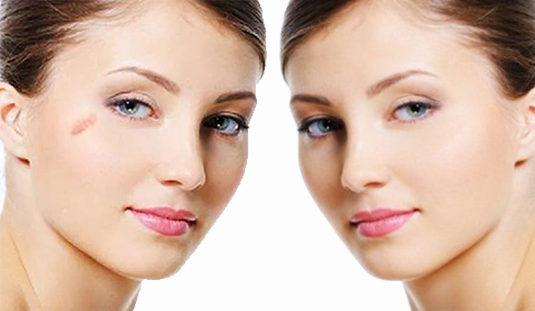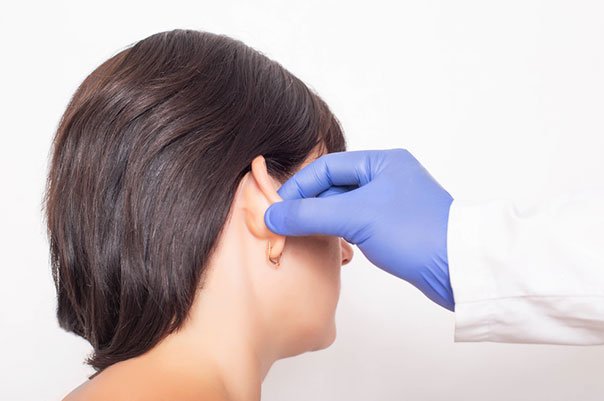

Birthmark Treatment at Skinbliss
What are birthmarks?
Birthmarks are benign (non-cancerous) skin spots or marks that are present at or near the time of birth, or develop shortly thereafter. They can appear in various shapes, sizes, and colors, ranging from tan, brown, or black to pink, red, or purple. There are two main types of birthmarks: vascular and pigmented.
Vascular birthmarks occur due to abnormal blood vessels beneath the skin’s surface. Examples include port wine stains, which are usually flat but may become more prominent over time, and hemangiomas, which are raised collections of blood vessels that typically grow during infancy before gradually shrinking and fading away.

Pigmented birthmarks result from an excess concentration of melanin, the pigment responsible for skin color. These marks can take several forms, such as café au lait spots (light brown patches), Mongolian spots (flat blue-gray marks often found on the lower back and buttocks), and moles (small, darkened growths).
While most birthmarks pose no health risks and do not require treatment, some may be associated with underlying medical conditions or cause cosmetic concerns. If you have any questions about a birthmark, it is best to consult a healthcare professional for evaluation and guidance.
What are the types of birthmarks?
There are primarily two categories of birthmarks based on their appearance and causes: vascular birthmarks and pigmented birthmarks. Here are some common types within each category:
Vascular Birthmarks:
Port Wine Stain: A flat, purplish-red mark caused by dilated capillaries close to the skin’s surface. Port wine stains tend to persist throughout life and sometimes thicken or become darker over time. They mostly affect the face, neck, arms, or legs.
Hemangioma: This type of birthmark appears as a collection of small, closely packed blood vessels under the skin. Hemangiomas can be superficial (on the skin’s surface) or deep (beneath the skin); they might start as faint red marks and later turn into raised bumps or nodules. Most hemangiomas disappear without intervention by age nine.
Salmon Patch (Nevus Simplex): Flat, light reddish-pink patches commonly found on the forehead, eyelids, nose, upper lip, or nape of the neck. Salmon patches are generally harmless and fade away on their own by two years of age. However, those located on the back of the neck (stork bites) may persist into adulthood.
Pyogenic Granuloma: Although these lesions aren’t technically considered birthmarks since they usually develop after birth, pyogenic granulomas resemble them. They appear as rapidly growing, bright red or purple papules due to increased blood vessel formation. Pyogenic granulomas can bleed easily if injured and may require removal through minor surgery.
Pigmented Birthmarks:
Café Au Lait Spot: Light brown, oval-shaped macules resulting from excessive melanin production. While isolated spots are common, multiple Café au Lait spots could indicate genetic disorders like neurofibromatosis.
Mongolian Spots: Bluish-black or gray discolorations occurring mainly on the lower back, buttocks, and shoulders. These marks are particularly prevalent among people of Asian, Native American, African, and Hispanic descent. Mongolian spots usually fade within five years but may occasionally persist into adolescence or beyond.
Congenital Melanocytic Nevi (CMNs) / Moles: Dark, irregularly shaped moles appearing at birth or soon afterward. The size of CMNs varies widely; larger ones carry a higher risk of becoming cancerous compared to smaller moles acquired later in life. Regular monitoring and dermatological evaluations are recommended for individuals with large congenital nevi.
Becker’s Nevus: Brownish-tan or patchy hyperpigmentation accompanied by coarse hair growth and slightly elevated texture. Becker’s nevus tends to enlarge during puberty and affects males more frequently than females. It does not regress spontaneously and requires surgical interventions if removal is desired.
Dermal Melanocytosis (Blue Nevus): Rare, bluish-gray or black pigmented patches resulting from deeply situated melanocytes (melanin-producing cells). Blue nevi remain stable throughout life and rarely transform into malignant tumors.
What causes birthmarks?
The exact causes of birthmarks are not fully understood; however, researchers believe that genetics and certain environmental factors play a role. Generally speaking, birthmarks fall into two primary categories – vascular and pigmented – each having distinct underlying mechanisms causing their development.
Vascular Birthmarks:
These marks form when there is an abnormality in the development of blood vessels under the skin. Various theories attempt to explain this phenomenon, including:
- Genetic mutations affecting blood vessel growth and regulation. For instance, a gene called ENG has been linked to some cases of hemangiomas.
- Disruptions in fetal blood flow leading to aberrant blood vessel formation. Factors like maternal hormones, placental issues, or external trauma during pregnancy might contribute to these disturbances.
Pigmented Birthmarks:
Pigmented birthmarks arise from alterations in melanin distribution or production within the skin. Some possible explanations include:
- Mutations in genes controlling melanin synthesis, transport, or degradation. An example is the HPS1 gene associated with some types of segmental lentiginous nevi (a specific pattern of pigmented birthmarks).
- Environmental triggers interacting with genetic susceptibility. Sun exposure, chemicals, or viruses might influence melanin production and accumulation, contributing to the formation of certain pigmented birthmarks.
How are Birthmarks Treated?
Treatment options for birthmarks depend on their type, location, size, and potential health risks. Many birthmarks don’t require any intervention as they either fade naturally over time or pose no significant concern. Nevertheless, some individuals may seek treatment for cosmetic reasons or if the birthmark poses functional problems (such as vision impairment). Several treatments are available at clinics specializing in skincare, such as SkinBliss Clinic in Jubilee Hills, Hyderabad, where experienced professionals like Dr. Deepali Marthineni provide personalized care.
Here are some common treatment methods used for various types of birthmarks:
Laser Therapy: Lasers target specific structures within the skin, allowing selective elimination of unwanted tissues. Vascular lasers, such as pulsed dye laser (PDL) and Nd:YAG lasers, are often employed to treat vascular birthmarks by collapsing dilated blood vessels, reducing redness, and improving overall appearance. Similarly, Q-switched ruby or Alexandrite lasers can break down excess melanin in pigmented birthmarks, enhancing skin tone and uniformity. At SkinBliss Clinic, advanced laser technology combined with expert clinical judgment ensures safe and effective results tailored to individual needs.
Surgical Excision: When birthmarks are extensive, protruding, or resistant to non-invasive therapies, surgical excision becomes an option. Under local or general anesthesia, the affected area is removed, leaving behind minimal scarring managed through careful planning and suturing techniques. Skilled surgeons like Dr. Deepali Marthineni at SkinBliss Clinic utilize modern approaches to optimize aesthetic outcomes while prioritizing patient safety and satisfaction.
Medications: Certain medications can help manage symptoms associated with specific types of birthmarks. Corticosteroids, for example, may reduce the size and inflammation of hemangiomas during critical periods of growth. Additionally, beta blockers have shown promise in treating problematic infantile hemangiomas. Topical creams containing retinoic acid derivatives, hydroquinone, or other agents might also benefit patients with particular pigmented birthmarks. Consulting with qualified practitioners at SkinBliss Clinic enables informed decision-making regarding pharmacologic interventions.
Remember, every case is unique; therefore, seeking professional advice from experts like Dr. Deepali Marthineni at SkinBliss Clinic in Jubilee Hills, Hyderabad, is essential to ensure appropriate assessment and customized treatment plans for optimal outcomes.
Why Choose Skinbliss Clinic?
SkinBliss Clinic stands out as an exceptional choice for addressing various skin concerns, including birthmarks, thanks to its commitment to excellence in numerous areas. By choosing SkinBliss Clinic, you can expect:
Expertise and Experience: SkinBliss Clinic boasts highly skilled professionals led by Dr. Deepali Marthineni, who brings extensive experience in diagnosing and treating various dermatological conditions. Their expertise guarantees accurate assessments and personalized treatment strategies tailored to your specific needs.
Advanced Technology: Equipment and cutting-edge laser systems enable precise, minimally invasive procedures with reduced downtime and superior results. SkinBliss Clinic continually invests in innovative technologies to offer the safest, most efficient treatments available.
Patient-Centered Care: At SkinBliss Clinic, patients come first. The team takes pride in fostering genuine connections with clients, ensuring open communication, empathy, and understanding throughout the entire process. From consultation to follow-up appointments, you’ll receive compassionate care centered around your goals and expectations.
Customized Solutions: Recognizing that each person’s skin is unique, SkinBliss Clinic provides bespoke treatment plans designed specifically for individual patients rather than one-size-fits-all solutions. This attention to detail maximizes effectiveness and minimizes side effects, promoting optimal outcomes.
Education and Support: Knowledgeable staff members at SkinBliss Clinic strive to empower clients through comprehensive education about their condition and available treatment options. Armed with this information, patients make informed decisions confidently, knowing they have a supportive team guiding them along the way.
Commitment to Safety: With rigorous standards for hygiene, sterilization, and infection control, SkinBliss Clinic maintains a clean, secure environment for all procedures. Strict protocols protect patient wellbeing while providing peace of mind during treatments.
Conclusion
To conclude, when considering birthmark treatment, it is essential to choose a reputable and experienced clinic equipped with advanced technologies and skilled professionals dedicated to providing personalized care. SkinBliss Clinic, located in Jubilee Hills, Hyderabad, India, embodies these qualities and more. Led by Dr. Deepali Marthineni, an accomplished dermatologist, SkinBliss Clinic combines medical expertise, facilities, and a strong emphasis on patient comfort and satisfaction to deliver excellent results in birthmark treatment.
By selecting SkinBliss Clinic, clients can expect individualized assessments, cutting-edge therapeutic modalities, expert surgical interventions when required, meticulous medication management, continuous support, and stringent safety protocols. Such a holistic approach allows clients to navigate their birthmark treatment journey with confidence, ultimately achieving enhanced skin health and self-assurance. Thus, SkinBliss Clinic serves as a trusted partner in helping individuals overcome their skin concerns and embrace their true selves.



